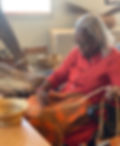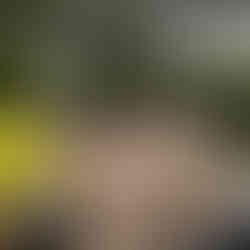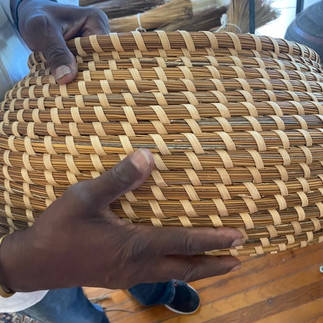ARTOBER: THE ECOLOGY OF GULLAH SWEETGRASS BASKETS, MARY JACKSON
- Jennifer Jewell
- 8 hours ago
- 10 min read

This week, we finish up Artober on CP, in conversation with artist Mary Jackson, a renowned sweetgrass basket weaver known for combining traditional methods with contemporary designs.
Based in the Low Country of South Carolina, Mary is the descendant of generations of Gullah basket weavers. Born in 1945, in 2008, Mary was awarded a MacArthur Foundation fellowship ("Genius Grant") for "pushing the centuries-old tradition in stunning new directions".
From the 1970s through to the early 2000s, Mary became something of an accidental Gardener, environmental restorationist, and economic driver when she recognized the dwindling supply and access to the signature native sweetgrass that her cultural art and tradition relied on. This diminishing resource was due in part to booming development along the U.S. Southeast coasts, the fragmentation and destruction of delicate coastal ecosystems, and the increasing exclusion of Gullah basketmakers from traditional harvest sites. Mary took it on herself to organize the basketmaking community, and working in collaboration with this community and Robert DuFault, of the Clemson University Department of Biological Sciences, her initiative led work to secure sustainable availability and access to native sweetgrass (Muhlenbergia sp.) for the traditional basket makers and the future of this traditional art, craft, and cultural symbol.
I first learned of the art and advocacy of Mary Jackson in the 1990s, when, as an award-winning Gullah Sweetgrass basket maker, she was working with Bob Dufault to understand the science of germinating native sweetgrass – a native coastal grass in the Muhlenbergia genus - in order to better grow it in cultivation, specifically to support generational Gullah Sweetgrass basket makers who were losing access to this culturally significant plant as both coastal development and habitat loss increased dramatically. Even at the time, I remember thinking: that is some large scale strategic gardening. Her advocacy work ultimately led to improved access for basket makers to existing native stands; led to restored native sweetgrass inner tidal dune ecosystems along Lowcountry coasts, and, ultimately to the introduction of several Muhlenbergia selections to the garden plant trade, for basket makers and the rest of us to grow in our home gardens and landscapes.
Gullah Sweetgrass baskets are an over 400-year tradition in the U.S. Southeast, first as a highly prized skill and centuries, if not millennia-old, passed-down knowledge of enslaved West Africans being brought to the colonies. These skills and knowledge directly contributed to the success, specifically of rice farming in the region, where highly developed and precisely crafted utilitarian baskets were used for everything from carrying, harvesting, winnowing, to fine household tasks.
Gullah Sweetgrass Baskets are a continued symbol of the City of Charleston, South Carolina, and for over a century, these skilled artists and their basketry have been an economic and cultural mainstay in the region. All depends on healthy and abundant native sweetgrass, palmetto, and loblolly or longleaf pine ecosystems and supply.
The “access” Mary catalyzed in response to this contraction of the health and supply of sweetgrass ultimately included: research into successful germination of sweetgrass at scale and teaching basket makers how to grow sweetgrass at home; the eventual introduction of Muhlenbergia species to the plant and garden trade, making it now a staple of the ornamental grass and native plant movements; large-scale plantings of the grasses on private and public grounds with permission for basketmakers to harvest and tend; and, finally, Army Corps of Engineers and coastal developments working to replant and restorate inter-tidal beach dunes with the stabilizing native sweetgrass.
All of this from one woman’s impulse to cultivate plants with an eye to protect the legacy of her people, and the future of their craft. Now an elder, Mary agreed to be one of the interview subjects of our 10 Cultivating Place Live events in 2024 and 2025. For the CP LIVE events, which will be included in the final Cultivating Place: The Power of Gardeners documentary film series, Jennifer interviewed Mary Jackson, Robert Dufault, and next-generation artist and Sweetgrass basket leader, Corey Alston, in front of a public audience in Theodora Park, Charleston, SC thanks to the partnership of David Rawle and Carol Perkins. This week’s podcast conversation was an interview with just Mary and Jennifer filmed and recorded live by EM EN in Mary’s Studio, on John’s Island, outside of Charleston.
The mandate for me in these CP LIVE experiences and interviews is to not only
give voice to (as the podcast always does), but actually make visible the many
diverse connections animated by the gardening impulse everywhere. What this
conversation makes visible to me, and I hope to all listeners, is that gardening is a multifaceted act – it is physical, it is intellectual, it is artistic and imaginative, it is tangible, and symbolic. It is one lens and method by which we know nature and art, and by which we participate in the regenerative artful nature of the world. When CP curated the 10 CP Live conversations and events around Cultivating Humans we saw as true keystones in their regions – culturally, environmentally, socially, economically, and more, Mary Jackson was an immediate choice.
Through her leadership and understanding of the many and complex natural and
human stories and processes required for the making of just one sweetgrass basket, let alone generations of them, so much else thrives around her.
Are artists Gardening our world? Mary Jackson and the many other generational Gullah sweetgrass basket makers of the coastal US Southeast are. The more we see and support the incredible diversity of who Gardeners are, what they grow, and what Gardens and Gardening mean, the better we grow our world.
ENJOY this artful conversation with elder, leader, and artist, Mary Jackson.
For those insterested in Mary and Robert J. Dufault's journey in sweetgrass cultivation, make sure to check out:
Springer Science & Business Media, Dec 9, 2012 - Science - 119 pages
"Stalking the Wild Sweetgrass: Domestication and Horticulture of the Grass Used in African-American Coiled Basketry" is concerned with the historical domestication of sweetgrass, the main construction/structural grass used in the three century old African-American tradition of coiled basketry in South Carolina. During the plantation era in southern agriculture, sweetgrass baskets were made for post-harvest processing and storage of rice by enslaved Africans from Lower Cape Fear, North Carolina to northern Florida. Enslaved Africans from the Rice Kingdom in Africa were prized for the basketry and
rice agronomic skills and were specially sought by slavery traders. Today, this ancient craft still thrives in the community of Mt. Pleasant, South Carolina.
Authored by one of the most renowned experts in the field and filled with illuminating color photographs, this volume provides knowledge of the horticulture of an extremely important wild plant and an example of the perils of plant- and people-based research and experimentation. As one of the few authoritative texts on the subject, Stalking the Wild Sweetgrass: Domestication and Horticulture of the Grass Used in African-American Coiled Basketry is a resourceful volume on wild sweetgrass, suitable for researchers and students alike.
For those interested in more about the history of Gullah Culture and the rich basketry tradition:
Corey Alston: thegullahculture.com/
"Row Upon Row, Sweet Grass Baskets of the South Carolina Low Country" by Dale Rosengarten & McKissick Museum (USC Press, 2022)
All photos courtesy of Jennifer Jewell and Cultivating Place, with the permission of Mary and Stoney Jackson, Robert Dufault, and Corey Alston. ALL RIGHTS RESERVED.
If you enjoyed this program, you might also enjoy these
Best of CP programs in our archive:
JOIN US again next week, when we head into November with ecological gardening from a place-based perspective takes our focus, especially given all that we CAN STILL PLAN AND PLANT IN THIS LAST stretch of the year. Host Ben Futa is back and in conversation with one of our favorite ecological gardening leaders, reporters, and gossip columnists: Rebecca MacMackin. That's right here, next week. Listen in!
Cultivating Place is made possible in part by listeners like you and by generous support
from
in honor of Bailey Shaw
supporting initiatives that empower women and help preserve the planet through the intersection of environmental advocacy, social justice, and creativity.
Thinking out loud this week...
Hey hey, it's Jennifer—
Wow, here we are at another seasonal seam, this liminal annual timeframe known by various names in various cultures around the globe. Halloween, Day of the Dead, All Souls, All Hallows, Sawein, so many end of growing, lowering light, lengthening dark and dormancy celebrations in this time of the year. This stretch from now to the Winter Solstice and Winter holidays feels charged with meaning, and with meaning-making.
To whit, thank you to ALL of you that participated in the inaugural ART of CP online art auction and fundraiser! It was phenomenal to interact with so many of you – to feel the appreciation for the artistry, for the concept, for the purpose if this Cultivating Place work. We exceeded our goals on all fronts! We could not have done It without all of the artists whose work was pure contribution. I hope you were all able to check them out on the auction pages, as we rolled them out in individual introductions on Instagram. I hope you followed them, applauded them, and celebrated the artists of our world – also helping to grow us better.
Tomorrow, Friday October 31st , we turn inward in some ways, while also deepening our sense of place as we kick off our first ever 100 day project together. We had an introductory journal making workshop with Margaux of Peg & Awl this morning, 10.30.25. For those registered to participate, if you could not make the morning gathering, we will be sending out a link to the recording! The challenge is free, but only registered participants and ensured weekly prompts, group updates, invitations, and links to communal get togethers. Join in any time! Link to register HERE.
Our goal is for this 100-day CP project to deepen our individual understandings of place, and our collective understanding of what Cultivating Place well means to all of us.
So glad to be crossing this seasonal marker with you all!
If you read this month’s New Moon Newsletter, you will recognize this
story, but I like it so much I want to share it here too: Shifting seasons always shift our perspectives, don’t they? In the Northern Hemisphere as fall deepens, we change clothes, we change preferred foods, drinks, activities; we change our bedtimes and our bed covers.
We literally shift views: where once there was a forest of biomass, we now see the individual architecture of trunks, branches; where once we saw a mass of green leaved canopies, we now see the flaming red, sunset apricot, orange, gold, cinnamon of photosynthesis subsiding, and senescence taking over. We gaze mesmerized at the fall and winter weather patterns tracing across the horizon; in this time, we see and respond to the different needs and natures of our plant companions. Our perspectives shift. Have shifted.
When a man came up to me in the line of book buyers after a long day of two talks at the Alachua County Horticultural Expo in Gainesville, Florida last week: he said this: “You have completely changed the way I see everything, he was so thoughtful and intent. He seemed surprised himself when he shared how the message of CP completely changed his perspective, how it changed the way he saw gardening in our world. And how he saw himself as a Big G Gardener. A potential keystone.
To invite others–as many others as possible–to see themselves and this calling to caring cultivation as profoundly important and valuable, is everything to me. To invite Gardeners and non-Gardeners alike to understand themselves as potential keystones holding and bringing together environments, economies, cultures, communities, and spirit: that is good growing. To witness even one additional person experience this shift in perspective is what success means here at Cultivating Place.
So glad to be growing here together. One Gardener at a time. One act of
IN Public Growing announcements this week two of happy note:
First up, on November 9th , if you are anywhere near the Berkshire Botanical Garden over this weekend, get yourself signed up for their annual Rooted IN Place Symposium, it is always excellent, but this year perhaps even more so with Abra Lee of Conquer the Soil as their keynote speaker.
Also, if you’re in the Northern California region and in driving distance of Chico, CA, and you love native plant holiday fun, you will not want to miss the Wonderful Winter Wreathing Weekend taking place on December 6th and 7th. The 6th is a Native Plant Wreathing Party with holiday bubble and wreathing at the Gateway Science Museum, December 7th is the down and dirty (in the best way) Native Plant Wreath workshop at the Ahart Herbarium at Chico State. There are limited spots for both events, and all proceeds go to the support of these two important cultural, biological, and natural history institutions! I will be in person at both events helping you craft just the right native plant holiday items. Sign up now!
Happy almost November, we are firmly in the season of Gratitude now, and I am grateful to be here with you.
WAYS TO SUPPORT CULTIVATING PLACE
Cultivating Place is a co-production of North State Public Radio, a service of Cap Radio, licensed to Chico State Enterprises. Cultivating Place is made possible in part listeners just like you through the support button at the top right-hand corner of every page at Cultivating Place.com.
The CP team includes producer and engineer Matt Fidler, with weekly tech and web support from Angel Huracha, weekly communications support by Sheila Stern and Carley Bruckner, transcripts by Doulos Transcription, and regular guest hosting by Abra Lee and Ben Futa. We’re based on the traditional and present homelands of the Mechoopda Indian Tribe of the Chico Rancheria. Original theme music is by Ma Muse, accompanied by Joe Craven and Sam Bevan.
SHARE the podcast with friends: If you enjoy these conversations about these things we love and which connect us, please share them forward with others. Thank you in advance!
RATE the podcast on iTunes: Or wherever you get your podcast feed: Please submit a ranking and a review of the program on Itunes! To do so follow this link: iTunes Review and Rate (once there, click View In Itunes and go to Ratings and Reviews)
DONATE: Cultivating Place is a listener-supported co-production of North State Public Radio. To make your listener contribution – please click the donate button below. Thank you in advance for your help making these valuable conversations grow.
Or, make checks payable to: Cultivating Place Foundation EIN #33-1665277
PO Box 37
Durham, CA 95938





































